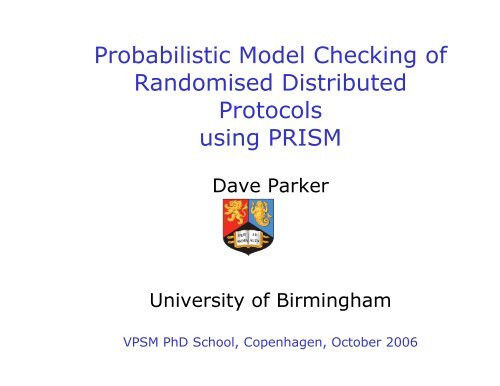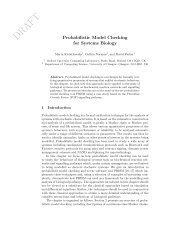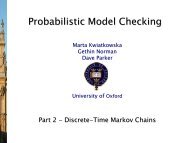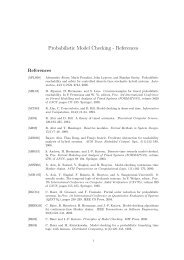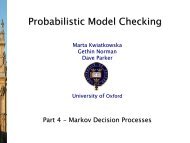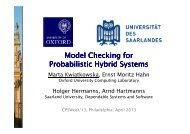Probabilistic Model Checking of Randomised Distributed ... - PRISM
Probabilistic Model Checking of Randomised Distributed ... - PRISM
Probabilistic Model Checking of Randomised Distributed ... - PRISM
Create successful ePaper yourself
Turn your PDF publications into a flip-book with our unique Google optimized e-Paper software.
<strong>Probabilistic</strong> <strong>Model</strong> <strong>Checking</strong> <strong>of</strong><strong>Randomised</strong> <strong>Distributed</strong>Protocolsusing <strong>PRISM</strong>Dave ParkerUniversity <strong>of</strong> BirminghamVPSM PhD School, Copenhagen, October 2006
Part IITool Support: <strong>PRISM</strong>
Overview• Tool support for probabilistic model checking• The <strong>PRISM</strong> tool−−−−−functionality, features, resourcesmodelling languageproperty specificationtool demoefficient symbolic implementations• Related work/research topics
Motivation• Complexity <strong>of</strong> PCTL model checking−generally polynomial in model size (number <strong>of</strong> states)• State space explosion problem−models for realistic case studies are typically huge• Clearly tool support is required• Benefits:−−−fully automated processhigh-level languages/formalisms for building modelsvisualisation <strong>of</strong> quantitative results
<strong>Probabilistic</strong> model checkers• <strong>PRISM</strong> (this talk) – DTMCs, MDPs, CTMCs + rewards• ETMCC/MRMC – DTMCs, CTMCs + reward extensions• LiQuor – LTL verification for MDPs (Probmela language)• RAPTURE - prototype for abstraction/refinement <strong>of</strong> MDPs• Simulation-based probabilistic model checking:−APMC, Ymer (both based on <strong>PRISM</strong> language)• CSL model checking for CTMCs: APNN-Toolbox, SMART• Multiple formalism/tool solutions: CADP, Möbius
The <strong>PRISM</strong> tool• <strong>PRISM</strong>: <strong>Probabilistic</strong> symbolic model checker− developed at the University <strong>of</strong> Birmingham, since approx. 1999−−free, open sourceversions for Linux, Unix, Mac OS X, Windows• Construction <strong>of</strong> models:−DTMCs, MDPs , CTMCs + costs/rewards• Verification <strong>of</strong>:−PCTL, CSL + extensions + costs/rewards• www.cs.bham.ac.uk/~dxp/prism
<strong>PRISM</strong> - Functionality• Constructs three types <strong>of</strong> probabilistic models:−−−DTMCs, MDPs, CTMCsalso: PTAs with digital clocks by manual translationaugmented with costs/rewards• The <strong>PRISM</strong> language – high-level model description language• <strong>PRISM</strong> simulator - generate model traces for debugging, etc.• Variety <strong>of</strong> import/export functionality:−−−−model output: text files, Dot graphs, Matlab, ETMCC/MRMCmodel import: text filesother input formalisms via language translation: PEPA, CSPdirect connections to other tools: APMC, ProVer/Ymer
• Supports verification <strong>of</strong>:<strong>PRISM</strong> - Functionality−−−PCTL (for DTMCs, MDPs), CSL (for CTMCs)plus “quantitative” extensionscost/reward-based properties• Powerful, flexible implementation−−−−efficient symbolic (BDD-based) implementationsmultiple computation engineswide range <strong>of</strong> model analysis methodssampling-based computation (discrete-event simulation)
<strong>PRISM</strong> - Functionality• Graphical user interface− model/property editor− easy automation <strong>of</strong> verification experiments− graphical visualisation <strong>of</strong> results− debugging tool: simulation engine• Command-line version− same underlying verification engines− useful for scripting, batch jobs
Getting <strong>PRISM</strong> + Other Resources• <strong>PRISM</strong> website: www.cs.bham.ac.uk/~dxp/prism−−−−−tool download: binaries, source codeonline example repository (40+ case studies)online documentationsupport: help forum, bug tracking, feature requests• hosted on Sourceforgerelated publications, links
<strong>PRISM</strong> modelling language• Simple, state-based language for DTMCs/MDPs/CTMCs−based on Reactive Modules [Alur/Henzinger]• Modules (system components, composed in parallel)• Variables (finite-valued, local or global)• Guarded commands (labelled with probabilities/rates)• Synchronisation (CSP-style) + process-algebraic operators(parallel composition, action hiding/renaming)[send] (s=2) -> p loss: (s'=3)&(lost'=lost+1) + (1-p loss) : (s'=4);action guard probability update probability update
<strong>PRISM</strong> language example// hermans self-stabilisation algorithm [Her90]dtmc // algorithm is synchronousmodule process1 // first <strong>of</strong> N=5 symmetric processesx1 : [0..1]; // one bit per process; xi=x(i-1) means process i has a token[step] (x1=x5) -> 0.5 : (x1'=0) + 0.5 : (x1'=1);[step] !x1=x5 -> (x1'=x5);endmodule// add further processes through renamingmodule process2 = process1 [ x1=x2, x5=x1 ] endmodulemodule process3 = process1 [ x1=x3, x5=x2 ] endmodulemodule process4 = process1 [ x1=x4, x5=x3 ] endmodulemodule process5 = process1 [ x1=x5, x5=x4 ] endmodule// can start in any possible configurationinit true endinit// cost - 1 in each state (expected number <strong>of</strong> steps)rewards true : 1; endrewards
<strong>PRISM</strong> – Property specifications• Based on (probabilistic extensions <strong>of</strong>) temporal logic−incorporates PCTL for DTMCs/MDPs, CSL for CTMCs• Examples:−−−P
<strong>PRISM</strong> – Property specifications• Focus on quantitative properties, compute actual values−P=? [ F≤T “shutdown” ] - “what is the probability <strong>of</strong> shutdownoccurring within T hours?”• Best/worst-case scenarios−−P=? [ F “error” {“init”}{max} ] - “what is the worst-caseerror probability over all possible initial configurations?”Pmin=? [ !end2 U end1 ] - “what is the minimum probability<strong>of</strong> process 1 finishing before process 2, over all possibleschedulings <strong>of</strong> the processes?”• Experiments – ranges <strong>of</strong> model/property parameters−−P=? [ F≤T error ] for N=1..5, T=1..100identify patterns, trends, anomalies in results
Probability that 10%<strong>of</strong> gate outputs areerroneous for varyinggate failure rates andnumbers <strong>of</strong> stagesWorst-case expectednumber <strong>of</strong> steps tostabilise for initialconfigurations with Ktokens amongst NprocessesOptimum probability<strong>of</strong> leader election bytime T for various coinbiases
Cost- and reward-based properties• Costs and rewards−real-valued quantities assigned to states/transitions• Instantaneous – state-based measures− current queue size, number <strong>of</strong> operational channels, ...−−“what is the expected size <strong>of</strong> the message queue at time t?”“what is the long-run expected size <strong>of</strong> the queue?”• Cumulative – state or transition (impulse) costs/rewards− time, power consumption, messages lost, ...− “what is the expected power consumption during the first 2hours <strong>of</strong> operation?”−“what is the worst-case expected time taken for the protocolto terminate?”
<strong>PRISM</strong> Demo
<strong>PRISM</strong> Screenshots
<strong>PRISM</strong> Screenshots
<strong>PRISM</strong> Screenshots
Efficiency - Symbolic techniques• State space explosion−models <strong>of</strong> real-life systems typically huge• Symbolic probabilistic model checking−−−data structures based on binary decision diagrams (BDDs)compact storage: exploit model structure and regularityefficient implementation <strong>of</strong> graph traversal fixed point algorithms• <strong>PRISM</strong>: multiple computation engines−−−MTBDDs (BDD extension): storage/analysis <strong>of</strong> very large models(given structure/regularity), numerical computation can blow upsparse matrices: fastest solution for smaller models (
Efficiency – Other strategies• Approximate model checking (see also APMC [LHP06])− sampling using Monte Carlo discrete-event simulation− performed at modelling language level – better scalability− potentially huge number <strong>of</strong> samples for accurate answers− also: statistical hypothesis testing, see e.g. [YS02]• Parallelisation <strong>of</strong> model checking− distribution <strong>of</strong> storage/computation across multi-processormachines [KPZM04], networked clusters [ZPK05], grids− potentially promising for symbolic approaches – reduced I/O− simulation-based computations much easier to distribute
Ongoing research areas• Abstraction and refinement, see e.g. [DJJL01,KNP06a]− construct smaller, abstract model by removinginformation/variables not relevant to property being checked,iteratively refine abstraction if analysis fails• Symmetry reduction [DM06, KNP06b]− exploit replication <strong>of</strong> identical components• Partial order reduction, see e.g. [BGC04], [DN04]− exploit commutativity <strong>of</strong> concurrently executed transitions• Compositionality, see e.g. [dAHJ01,Che06]− analyse full model based on analysis <strong>of</strong> sub-components
References• [BGC04] C. Baier, M. Grosser, and F. Ciesinski. Partial order reductionfor probabilistic systems. In Proc. QEST’04, pages 230–239. IEEEComputer Society Press, 2004.• [Che06] L. Cheung. Reconciling Nondeterministic and <strong>Probabilistic</strong>Choices. Ph.D. thesis, Radboud University <strong>of</strong> Nijmegen. 2006.• [DJJL01] P. D’Argenio, B. Jeannet, H. Jensen, and K. Larsen.Reachability analysis <strong>of</strong> probabilistic systems by successive refinements.In Proc. PAPM/PROBMIV’01, volume 2165 <strong>of</strong> LNCS, pages 39–56,Springer, 2001.• [DN04] P. D’Argenio and P. Niebert. Partial order reduction onconcurrent probabilistic programs. In Proc. QEST’04, pages 240–249.IEEE Computer Society Press, 2004.
References• [dAHJ01] L. de Alfaro, T. Henzinger and R. Jhala. CompositionalMethods for <strong>Probabilistic</strong> Systems. In CONCUR 01: Concurrency Theory,12th International Conference, LNCS, Springer-Verlag, 2001.• [DM06] A. Donaldson and A. Miller. Symmetry Reduction for<strong>Probabilistic</strong> <strong>Model</strong> <strong>Checking</strong> using Generic Representatives. In Proc. 4thInternational Symposium on Automated Technology for Verification andAnalysis (ATVA'06), Springer. October 2006.• [KNP06a] M. Kwiatkowska, G. Norman and D. Parker. Game-basedAbstraction for Markov Decision Processes. In Proc. 3rd InternationalConference on Quantitative Evaluation <strong>of</strong> Systems (QEST'06), pages 157-166, IEEE CS Press. 2006.• [KNP06b] M. Kwiatkowska, G. Norman and D. Parker. SymmetryReduction for <strong>Probabilistic</strong> <strong>Model</strong> <strong>Checking</strong>. In Proc. 18th InternationalConference on Computer Aided Verification (CAV'06), volume 4144 <strong>of</strong>LNCS, pages 234-248, Springer, 2006.
References• [KPZM04] M. Kwiatkowska, D. Parker, Y. Zhang and R. Mehmood.Dual-Processor Parallelisation <strong>of</strong> Symbolic <strong>Probabilistic</strong> <strong>Model</strong> <strong>Checking</strong>.In Proc. MASCOTS'04, pages 123-130, IEEE CS Press. 2004.• [LHP06] R. Lassaigne, T. Hérault and S. Peyronnet. APMC 3.0:Approximate verification <strong>of</strong> Discrete and Continuous Time Markov Chains.In Proc. 3rd International Conference on Quantitative Evaluation <strong>of</strong>Systems (QEST'06), 2006.• [YS02] H. Younes and R. Simmons. <strong>Probabilistic</strong> verification <strong>of</strong> discreteevent systems using acceptance sampling. In Proceedings <strong>of</strong> the 14thInternational Conference on Computer Aided Verification, volume 2404 <strong>of</strong>LNCS, pages 223-235, Copenhagen, Denmark, July 2002.• [ZPK05] Y. Zhang, D. Parker and M. Kwiatkowska. A WavefrontParallelisation <strong>of</strong> CTMC Solution using MTBDDs. In Proc. InternationalConference on Dependable Systems and Networks (DSN'05), pages 732-742, IEEE Computer Society Press. 2005.


